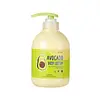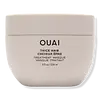What's inside
What's inside
 Key Ingredients
Key Ingredients

No key ingredients
 Benefits
Benefits

 Concerns
Concerns

 Ingredients Side-by-side
Ingredients Side-by-side

Water
Skin ConditioningGlycerin
HumectantCetyl Ethylhexanoate
EmollientCetyl Alcohol
EmollientCyclopentasiloxane
EmollientCaprylic/Capric Triglyceride
MaskingButylene Glycol
HumectantPanthenol
Skin ConditioningPersea Gratissima Fruit Extract
EmollientCentella Asiatica Extract
CleansingPortulaca Oleracea Extract
Skin ConditioningCarica Papaya Fruit Extract
Skin ConditioningGlyceryl Stearate
EmollientStearyl Alcohol
EmollientCyclohexasiloxane
EmollientPEG-100 Stearate
PEG/PPG-17/6 Copolymer
SolventDimethicone
EmollientPalmitic Acid
EmollientStearic Acid
CleansingPolysorbate 60
EmulsifyingMyristyl Alcohol
EmollientCarbomer
Emulsion StabilisingArginine
MaskingLauryl Alcohol
EmollientXanthan Gum
EmulsifyingMyristic Acid
CleansingArachidic Acid
CleansingLauric Acid
CleansingOleic Acid
EmollientDisodium EDTA
Chlorphenesin
AntimicrobialEthylhexylglycerin
Skin Conditioning1,2-Hexanediol
Skin ConditioningParfum
MaskingLinalool
PerfumingLimonene
PerfumingHexyl Cinnamal
PerfumingButylphenyl Methylpropional
PerfumingGeraniol
PerfumingCitronellol
PerfumingWater, Glycerin, Cetyl Ethylhexanoate, Cetyl Alcohol, Cyclopentasiloxane, Caprylic/Capric Triglyceride, Butylene Glycol, Panthenol, Persea Gratissima Fruit Extract, Centella Asiatica Extract, Portulaca Oleracea Extract, Carica Papaya Fruit Extract, Glyceryl Stearate, Stearyl Alcohol, Cyclohexasiloxane, PEG-100 Stearate, PEG/PPG-17/6 Copolymer, Dimethicone, Palmitic Acid, Stearic Acid, Polysorbate 60, Myristyl Alcohol, Carbomer, Arginine, Lauryl Alcohol, Xanthan Gum, Myristic Acid, Arachidic Acid, Lauric Acid, Oleic Acid, Disodium EDTA, Chlorphenesin, Ethylhexylglycerin, 1,2-Hexanediol, Parfum, Linalool, Limonene, Hexyl Cinnamal, Butylphenyl Methylpropional, Geraniol, Citronellol
Water
Skin ConditioningCetyl Alcohol
EmollientBehentrimonium Chloride
PreservativeCetearyl Alcohol
EmollientButyrospermum Parkii Butter
Skin ConditioningAmodimethicone
Behentrimonium Methosulfate
Hydrogenated Castor Oil/Sebacic Acid Copolymer
EmollientStearamidopropyl Dimethylamine
EmulsifyingCetyl Esters
EmollientQuaternium-87
CleansingC18-38 Alkyl Hydroxystearoyl Stearate
EmollientOlea Europaea Fruit Oil
MaskingPropylene Glycol Dibenzoate
Skin ConditioningPrunus Amygdalus Dulcis Oil
Skin ConditioningMacadamia Ternifolia Seed Oil
EmollientKeratin
Skin ConditioningHydrolyzed Keratin
HumectantHydrolyzed Pea Protein
EmollientHydrolyzed Adansonia Digitata Seed Extract
Shorea Stenoptera Seed Butter
EmollientTocopherol
AntioxidantC10-40 Isoalkylamidopropylethyldimonium Ethosulfate
Ascorbyl Palmitate
AntioxidantCaprylyl Glycol
EmollientBHT
AntioxidantTrideceth-3
EmulsifyingTrideceth-15
EmulsifyingAcetic Acid
BufferingDimethicone
EmollientLaureth-23
CleansingLaureth-4
EmulsifyingSalicylic Acid
MaskingDivinyldimethicone/Dimethicone Copolymer
C12-13 Pareth-23
CleansingC12-13 Pareth-3
EmulsifyingSodium Hydroxide
BufferingHydroxyethylcellulose
Emulsion StabilisingDisodium Phosphate
BufferingSodium Phosphate
BufferingPolysorbate 60
EmulsifyingGuar Hydroxypropyltrimonium Chloride
Skin ConditioningCitric Acid
BufferingDisodium EDTA
Cetrimonium Chloride
AntimicrobialSodium Chloride
MaskingIsopropyl Alcohol
SolventPotassium Sorbate
PreservativeBenzyl Alcohol
PerfumingSodium Benzoate
MaskingPhenoxyethanol
PreservativeParfum
MaskingLinalool
PerfumingCitronellol
PerfumingWater, Cetyl Alcohol, Behentrimonium Chloride, Cetearyl Alcohol, Butyrospermum Parkii Butter, Amodimethicone, Behentrimonium Methosulfate, Hydrogenated Castor Oil/Sebacic Acid Copolymer, Stearamidopropyl Dimethylamine, Cetyl Esters, Quaternium-87, C18-38 Alkyl Hydroxystearoyl Stearate, Olea Europaea Fruit Oil, Propylene Glycol Dibenzoate, Prunus Amygdalus Dulcis Oil, Macadamia Ternifolia Seed Oil, Keratin, Hydrolyzed Keratin, Hydrolyzed Pea Protein, Hydrolyzed Adansonia Digitata Seed Extract, Shorea Stenoptera Seed Butter, Tocopherol, C10-40 Isoalkylamidopropylethyldimonium Ethosulfate, Ascorbyl Palmitate, Caprylyl Glycol, BHT, Trideceth-3, Trideceth-15, Acetic Acid, Dimethicone, Laureth-23, Laureth-4, Salicylic Acid, Divinyldimethicone/Dimethicone Copolymer, C12-13 Pareth-23, C12-13 Pareth-3, Sodium Hydroxide, Hydroxyethylcellulose, Disodium Phosphate, Sodium Phosphate, Polysorbate 60, Guar Hydroxypropyltrimonium Chloride, Citric Acid, Disodium EDTA, Cetrimonium Chloride, Sodium Chloride, Isopropyl Alcohol, Potassium Sorbate, Benzyl Alcohol, Sodium Benzoate, Phenoxyethanol, Parfum, Linalool, Citronellol
 Reviews
Reviews

Ingredients Explained
These ingredients are found in both products.
Ingredients higher up in an ingredient list are typically present in a larger amount.
Cetyl Alcohol is a fatty alcohol. Fatty Alcohols are most often used as an emollient or to thicken a product.
Its main roles are:
Though it has "alcohol" in the name, it is not related to denatured alcohol or ethyl alcohol.
The FDA allows products labeled "alcohol-free" to have fatty alcohols.
Learn more about Cetyl AlcoholCitronellol is used to add fragrance/parfum to a product. It is often derived from plants such as roses. In fact, it can be found in many essential oils including geranium, lavender, neroli, and more. The scent of Citronellol is often described as "fresh, grassy, and citrus-like".
Since the Citronellol molecule is already unstable, Citronellol becomes irritating on the skin when exposed to air.
Citronellol is a modified terpene. Terpenes are unsaturated hydrocarbons found in plants. They make up the primary part of essential oils.
Citronellol is not able to be absorbed into deeper layers of the skin. It has low permeability,
Citronellol is also a natural insect repellent.
Learn more about CitronellolDimethicone is a type of synthetic silicone created from natural materials such as quartz.
What it does:
Dimethicone comes in different viscosities:
Depending on the viscosity, dimethicone has different properties.
Ingredients lists don't always show which type is used, so we recommend reaching out to the brand if you have questions about the viscosity.
This ingredient is unlikely to cause irritation because it does not get absorbed into skin. However, people with silicone allergies should be careful about using this ingredient.
Note: Dimethicone may contribute to pilling. This is because it is not oil or water soluble, so pilling may occur when layered with products. When mixed with heavy oils in a formula, the outcome is also quite greasy.
Learn more about DimethiconeDisodium EDTA plays a role in making products more stable by aiding other preservatives.
It is a chelating agent, meaning it neutralizes metal ions that may be found in a product.
Disodium EDTA is a salt of edetic acid and is found to be safe in cosmetic ingredients.
Learn more about Disodium EDTALinalool is a fragrance and helps add scent to products. It's derived from common plants such as cinnamon, mint, citrus, and lavender.
Like Limonene, this ingredient oxidizes when exposed to air. Oxidized linalool can cause allergies and skin sensitivity.
This ingredient has a scent that is floral, spicy tropical, and citrus-like.
Learn more about LinaloolParfum is a catch-all term for an ingredient or more that is used to give a scent to products.
Also called "fragrance", this ingredient can be a blend of hundreds of chemicals or plant oils. This means every product with "fragrance" or "parfum" in the ingredients list is a different mixture.
For instance, Habanolide is a proprietary trade name for a specific aroma chemical. When used as a fragrance ingredient in cosmetics, most aroma chemicals fall under the broad labeling category of “FRAGRANCE” or “PARFUM” according to EU and US regulations.
The term 'parfum' or 'fragrance' is not regulated in many countries. In many cases, it is up to the brand to define this term.
For instance, many brands choose to label themselves as "fragrance-free" because they are not using synthetic fragrances. However, their products may still contain ingredients such as essential oils that are considered a fragrance by INCI standards.
One example is Calendula flower extract. Calendula is an essential oil that still imparts a scent or 'fragrance'.
Depending on the blend, the ingredients in the mixture can cause allergies and sensitivities on the skin. Some ingredients that are known EU allergens include linalool and citronellol.
Parfum can also be used to mask or cover an unpleasant scent.
The bottom line is: not all fragrances/parfum/ingredients are created equally. If you are worried about fragrances, we recommend taking a closer look at an ingredient. And of course, we always recommend speaking with a professional.
Learn more about ParfumPolysorbate 60 is used to help stabilize products. It is a surfactant and emulsifier. These properties help keep ingredients together in a product. Surfactants help reduce surface tension between ingredients with different states, such as liquids and solids. Emulsifiers help prevent oils and waters from separating.
Polysorbate 60 is sorbitol-based and created from the ethoxylation of sorbitan. Ethoxylation is a chemical reaction used to add ethylene oxide. Sorbitan is a the dehydrated version of sorbitol, a sugar found in fruits.
In this case, the 60 comes from reacting 60 units of ethylene oxide with sorbitan.
Polysorbates are commonly used in medicine and foods.
Learn more about Polysorbate 60Water. It's the most common cosmetic ingredient of all. You'll usually see it at the top of ingredient lists, meaning that it makes up the largest part of the product.
So why is it so popular? Water most often acts as a solvent - this means that it helps dissolve other ingredients into the formulation.
You'll also recognize water as that liquid we all need to stay alive. If you see this, drink a glass of water. Stay hydrated!
Learn more about Water